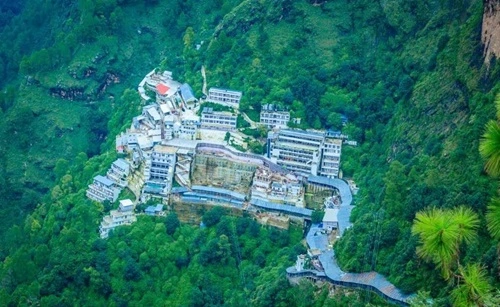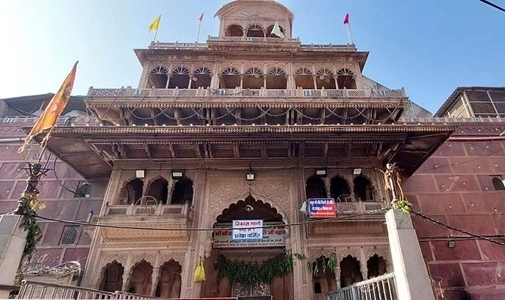Priyanka Singh*
*Ganga Aqualife Conservation Monitoring Centre, Wildlife Institute of India, Chandrabani, Dehradun, Uttarkhand-248001, India
Email: priyamunesh91@gmail.com , Mobile No.: +91-7579435235
The Mahakumbh Mela is more than just a festival—it is a grand confluence of faith, culture, and spirituality, held on a scale unmatched by any other gathering on Earth. Hosted at Prayagraj (formerly Allahabad), where the sacred rivers Ganga, Yamuna, and the mythical Saraswati merge, the Mahakumbh occurs only once every 144 years, making it a once-in-a-lifetime event for anyone fortunate enough to witness it.
In 2025, this holy event commenced on January 13, attracting more than 64 crore (640 million) pilgrims, devotees, ascetics, travelers, and seekers from all over India and the world. The scale of the Mahakumbh cannot be comprehended until it is experienced firsthand. I was blessed with the unusual opportunity to participate in this spectacular spiritual festival, and the experience has changed me forever.
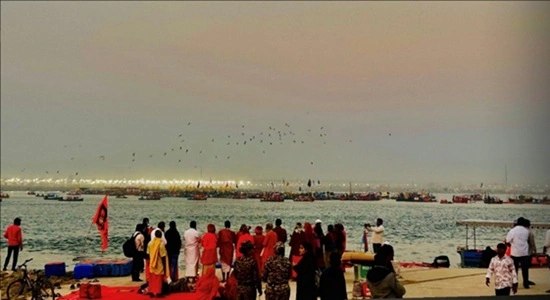
Ganga Arti at Sangam Ghat
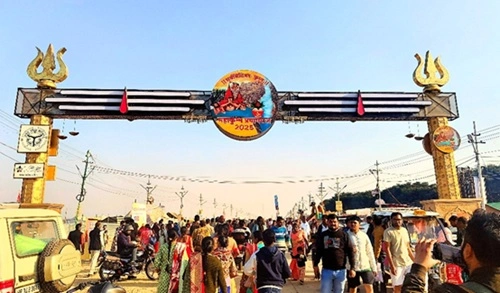
Devotees walk through the symbolic Mahadwar gate
Arrival: The Energy of Faith
The moment I reached Prayagraj; I was immersed in a sea of collective energy. The whole city had become a religious hub. Streets were adorned with saffron flags and colored banners, and loudspeakers blared chants, bhajans, and mantras. Burning incense sticks and holy smoke filled the air, and the people flowed like rivers, some walking in silence in deep thought, some singing in ecstasy of devotion.
Wherever I turned, there was activity, color, and life. Pilgrims had journeyed from far-flung villages, busy metros, neighboring nations, and even continents, all bound by a common need to cleanse themselves of their sins and be a part of this spiritual phenomenon. The magnitude of the arrangements—makeshift tents, food stalls, medical facilities, and security—was mindboggling. But amid chaos, there was an unmistakable sense of order through devotion.
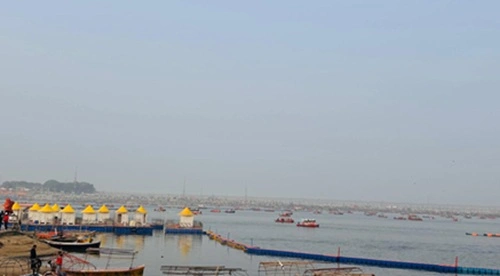
Boats float on the Ganga, with pilgrim camps lining the riverbanks
The Shahi Snan on Mauni Amavasya
One of the most moving and memorable experiences during my journey was taking part in the Shahi Snan on Mauni Amavasya on 29th January 2025—the most sacred day of the Kumbh. It is believed that a sacred dip on this day brings moksha (freedom from the cycle of birth and death).
At dawn, I traveled to Arail Ghat, one of the primary sites for the ritual bath. The atmosphere was cool and fresh, filled with the blaring of conch shells and the persistent drone of prayers. Thousands had already arrived, standing shoulder to shoulder, patiently awaiting the moment when the alignment in the heavens would sanctify the waters.
As the first light crept across the sky, bands of Naga Sadhus, dressed in ash and saffron, appeared in stately processions. Their presence, wild but peaceful, hushed the crowd into awe. Seeing them plunge into the water, followed by wave after wave of pilgrims, was like seeing something old and timeless.
As my turn arrived, I waded into the Ganges with my heart pounding. Cold sacred water touched my body, and as I went under, I experienced a shock of stillness—an interior brisance that transcended thought. Time seemed to stop. Clambering out of the water, I felt light—cleaned—and deeply shaken. That immersion was more than just ritual—it was a spiritual rebirth.
Walking Through the Akharas
No Mahakumbh is complete without a visit to the Akharas, the religious sects and monastic orders that are inextricably woven into the festival. I ensured that I visited a few of them, such as the Kinnar Akhara, the Naga Sadhus, and the Aghoris.
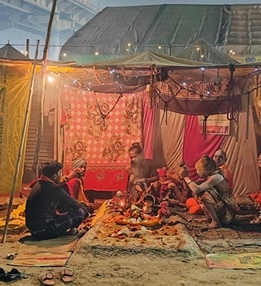
A sacred moment captured inside an Aghoris Akhara |
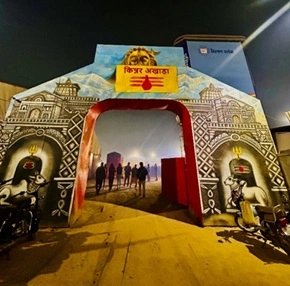
Gateway to faith and identity- Kinnar Akhara |
The Kinnar Akhara, under transgender spiritual leaders, was especially insightful. Their existence was a stark and stunning testament that spirituality cannot be confined within the bounds of gender, caste, or identity. Their boisterous energy and universal message represented the progressive spiritual narrative of India, in which all are welcomed into the divine order despite their background.
Encountering the Naga Sadhus was like entering into a page out of ancient history. These monks, who give up all material possessions and live in utmost austerity, have an aura of timelessness about them. Covered in ash on their bodies and with eyes seeming to bear deep meditation within them, they appeared not so much like human beings but more like elements of nature. Their restraint, silence, and detachment forced me to question the essence of surrender.
Then the Aghoris arrived—possibly the most enigmatic of all. With their unorthodox rituals and philosophy of accepting all that society abhors, the Aghoris defy the duality of purity and filth. Conversing with one of them was like a dream. Their perspective that everything in the universe is divine—even that which we fear or abhor—left me with much to think about. It was a stark but interesting take on freedom from societal and spiritual constraints.
A Tapestry of Culture, Community, and Service
What makes the Mahakumbh truly extraordinary is that it’s not just a spiritual festival—it’s a living expression of Indian culture and humanity. Processions of Saints, folk dancers, devotional singers, fire rituals, and spiritual discourses turned the entire venue into a cosmic stage. Each moment felt like a scene from a mythological epic being played out in real-time.
However, in all this grandeur, the true pulse of the Mela was its people. Organizations, volunteers, and millions of individuals toiled day and night to feed, medicate, house, and give clean water to millions. The philosophy of seva—selfless service—was not only preached but lived on a massive scale. Even strangers helped each other out, giving us the sense that we were all members of the same spiritual family.
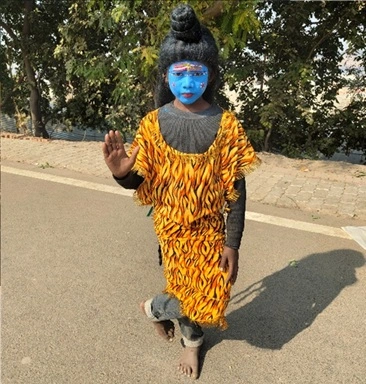
Shiva in colors: A child’s tribute to the divine at Mahakumbh
Reflections: A Pilgrimage Beyond Time
In retrospect, my journey at the Mahakumbh Mela seems almost like a dream. It was not only a pilgrim journey across geography, but a profound inner journey across faith, reflection, and transcendence. To be in the midst of millions, all searching for peace, forgiveness, and unity, was to see that at our essence, we are all pilgrims, following diverse paths to the same truth.
The Mahakumbh Mela is not a festival, it is a celebration of life, an assertion of our common humanity, and a rich exemplar of unity in diversity. It has made an unforgettable impression on my soul, one that will serve to counsel me when times are difficult and remind me of the power of belief, the wonder of community, and the potency of devotion.
In each step I made at the Mela, be it from the divine waters to the divine ash, I was a part of something that seemed to transcend time. And that, maybe, is the real magic of the Mahakumbh, a transitory phenomenon that leaves a timeless change behind.

Faith and devotion in every step, a saint’s procession at Mahakumbh
#Photo Credit: All the photographs are clicked by Priyanka Singh.
